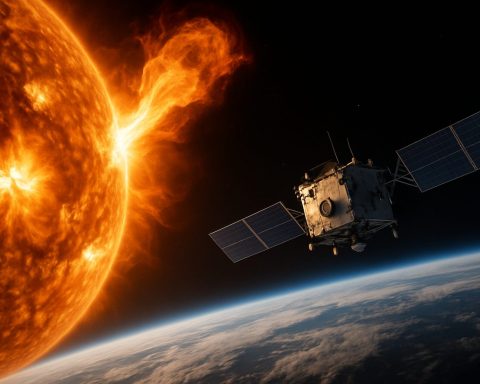- U.S. stock markets experienced severe losses, with $2.4 trillion in market value disappearing in one day.
- President Trump’s sweeping tariff announcement triggered the largest market drop since March 2020, leading to significant investor anxiety.
- Major tech leaders, such as Mark Zuckerberg, Jeff Bezos, and Elon Musk, faced multibillion-dollar losses as their companies’ stock values plummeted.
- The S&P 500, Dow Jones, and Nasdaq indexes nosedived, with the Dow falling 1,700 points and Nasdaq declining by 6%.
- Apple’s stock price fell over 9% due to its ties with Chinese manufacturing, exacerbating market fears.
- Global markets braced for retaliation, raising concerns about a potential global recession.
- Despite the turmoil, there is cautious optimism for future stabilization through negotiations and policy adjustments.
- Unpredictability in economic landscapes demands vigilance from investors to navigate market fluctuations.
Beneath the skyscrapers of Wall Street, a ripple of uncertainty transformed into a tidal wave as the clock struck Thursday. The world’s financial giants trembled as the ominous echo of tariffs thundered through the market, sending the S&P 500 into a staggering retreat. Investors, glued to their screens, witnessed an acrylic blur of red numbers as a remarkable $2.4 trillion in stock market value vanished in a single day. It was the market’s most significant drop since the chaos of March 2020.
The weight of President Trump’s sweeping tariff announcement bore down hard, eclipsing even the gloomiest predictions. Investors braced for impact as the economic landscape darkened, and inflation loomed like a shadowy specter over future growth. The U.S. dollar, often a bastion of strength, faltered against currencies like the yen and the Swiss franc, adding to the distress.
The tremors of this economic earthquake weren’t felt solely by the average investor; they reached the penthouses of billionaires. Mark Zuckerberg saw $17.9 billion evaporate as Meta’s waves crashed ashore. Across the industry spectrum, Jeff Bezos and Elon Musk witnessed billions slip through their fingers, as Amazon and Tesla stumbled down their own precarious paths.
Numbers became narratives: the Dow plummeted by 1,700 points, while the Nasdaq slumped by 6%, resembling a formidable roller coaster plunge. Apple’s stock, interwoven with Chinese manufacturing, tumbled over 9% in a single stroke, deepening the chasm.
Analysts dissected the event with acute precision. Skepticism brewed over the policies that had initially been hailed as the torchbearers of economic brilliance. The concern wasn’t only domestic. The shadows of global recession loomed as governments envisaged retaliations, forming a narrative ripe with unease and unpredictability.
Despite the storm, hope lingered. As discussions unfolded and expert predictions lined the horizon, the possibility of stabilization shimmered faintly. Investors dared to dream of negotiations, of calmer waters where tariff peaks could ease.
Amidst this upheaval, a key lesson resounded: economic landscapes are as unpredictable as weather patterns. Just as swiftly as seas can rise, they can calm—giving the vigilant observer a chance to steer their course in the ever-fluctuating market tides.
Wall Street Turbulence: Navigating Market Volatility in the Face of New Tariff Announcements
The recent stock market turbulence, marked by a dramatic $2.4 trillion loss in value, underscores the volatility of global financial markets and the far-reaching impact of tariff announcements. This event, sparked by sweeping tariffs announced by President Trump, has raised numerous questions and concerns among investors and economic analysts alike. Below, we delve into the layers of information surrounding this market upheaval and explore actionable insights to help navigate these uncertain economic waters.
The Ripple Effects of Tariffs on Global Markets
Tariffs often lead to cascading effects that go beyond immediate financial losses:
– Global Trade Tensions: Tariffs can escalate into trade wars, as countries retaliate against perceived economic aggressions. This scenario prompts investors to recalibrate their portfolios to minimize exposure to affected sectors.
– Currency Fluctuations: The weakening of the U.S. dollar against the yen and the Swiss franc signals shifting global investment strategies, potentially impacting import and export dynamics.
Economic Indicators and Predictions
The stock market’s reaction signifies broader economic implications:
– Inflation Concerns: Tariffs can drive up prices for consumer goods, contributing to inflationary pressures. As costs rise, consumer spending may decline, slowing economic growth.
– Market Sentiment: Investor confidence is crucial. The rapid decline in major indexes like the Dow and Nasdaq reflects a collective uncertainty that can dampen long-term investment strategies.
Market Strategies and Investor Insights
Given the current climate, investors should consider these strategies:
– Diversification: Diversifying investments across sectors and geographies can cushion against localized market disturbances.
– Hedging Strategies: Using tools such as options and futures can protect portfolios against unexpected market swings.
– Timely Reassessment: Regularly reviewing investment goals and risk tolerance ensures alignment with current market realities.
Real-World Use Cases and Expert Opinions
– Tech Giants Under Pressure: Companies like Meta, Amazon, and Tesla, which are significantly impacted due to their reliance on global supply chains, demonstrate how closely stock performance is tied to global economic policies.
– Manufacturing and Retail Impacts: Businesses involved in manufacturing and retail might experience increased costs, prompting them to adjust prices or seek alternative suppliers.
Industry Trends and Future Outlook
– Resilience Building: Companies and investors increasingly emphasize building resilient supply chains and investment portfolios to withstand geopolitical events.
– Policy Adjustments: Policymakers may need to explore alternative economic strategies, like trade negotiations and diplomatic engagements, to stabilize markets.
Actionable Recommendations
For investors feeling the ripples of this market shock, these tips may help:
– Stay Informed: Keeping abreast of policy changes and market reactions is vital. Utilize credible sources such as Reuters and Wall Street Journal for reliable updates.
– Consult Financial Advisors: Engaging with financial experts can provide personalized strategies to navigate market volatility.
– Maintain a Long-Term Perspective: Market fluctuations are part of the investment landscape; maintaining focus on long-term goals can help weather short-term volatility.
Conclusion
The unpredictable nature of economic landscapes requires vigilance and adaptability. By understanding the nuances of tariff impacts and adopting informed strategies, investors can navigate market turbulence with resilience and foresight. As history has demonstrated, market storms do pass, often paving the way for new opportunities in their wake.













